Attached files
| file | filename |
|---|---|
| 8-K - 8-K - PBF Energy Inc. | a8-kpbf3x24x15.htm |
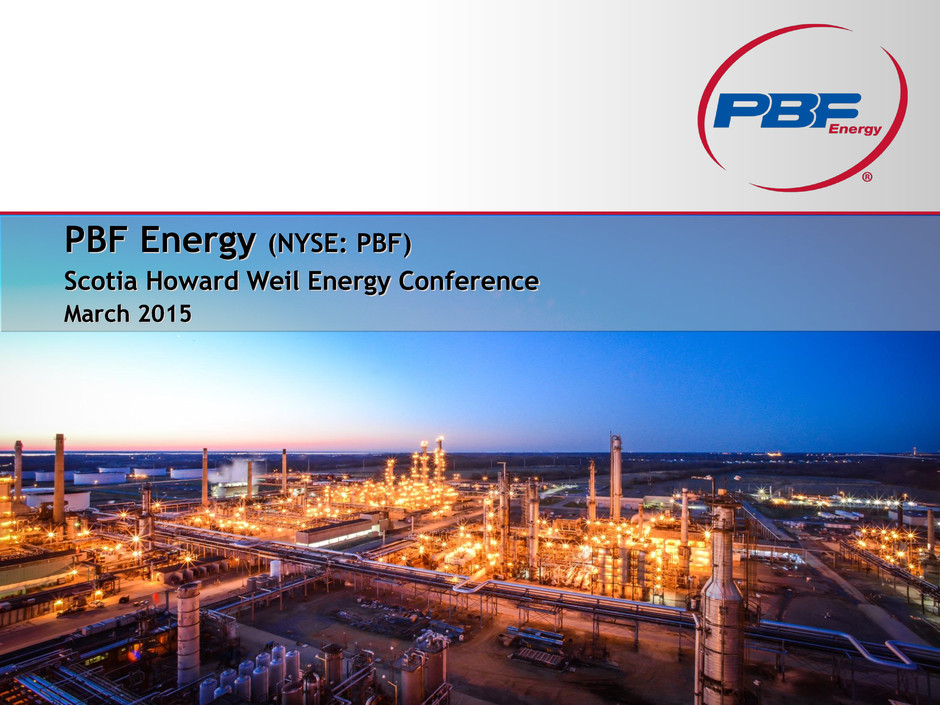
PBF Energy (NYSE: PBF) Scotia Howard Weil Energy Conference March 2015

2 Safe Harbor Statements This presentation contains forward-looking statements made by PBF Energy Inc. and PBF Logistics LP (together, the “Companies”, or “PBF” or “PBFX”) and their management teams. Such statements are based on current expectations, forecasts and projections, including, but not limited to, anticipated financial and operating results, plans, objectives, expectations and intentions that are not historical in nature. Forward-looking statements should not be read as a guarantee of future performance or results, and may not necessarily be accurate indications of the times at, or by which, such performance or results will be achieved. Forward-looking statements are based on information available at the time, and are subject to various risks and uncertainties that could cause the Companies’ actual performance or results to differ materially from those expressed in such statements. Factors that could impact such differences include, but are not limited to, changes in general economic conditions; volatility of crude oil and other feedstock prices; fluctuations in the prices of refined products; the impact of disruptions to crude or feedstock supply to any of our refineries, including disruptions due to problems with third party logistics infrastructure; effects of litigation and government investigations; the timing and announcement of any potential acquisitions and subsequent impact of any future acquisitions on our capital structure, financial condition or results of operations; changes or proposed changes in laws or regulations or differing interpretations or enforcement thereof affecting our business or industry, including any lifting by the federal government of the restrictions on exporting U.S. crude oil; actions taken or non-performance by third parties, including suppliers, contractors, operators, transporters and customers; adequacy, availability and cost of capital; work stoppages or other labor interruptions; operating hazards, natural disasters, weather-related delays, casualty losses and other matters beyond our control; inability to complete capital expenditures, or construction projects that exceed anticipated or budgeted amounts; inability to successfully integrate acquired refineries or other acquired businesses or operations; effects of existing and future laws and governmental regulations, including environmental, health and safety regulations; and, various other factors. Forward-looking statements reflect information, facts and circumstances only as of the date they are made. The Companies assume no responsibility or obligation to update forward-looking statements to reflect actual results, changes in assumptions or changes in other factors affecting forward-looking information after such date.
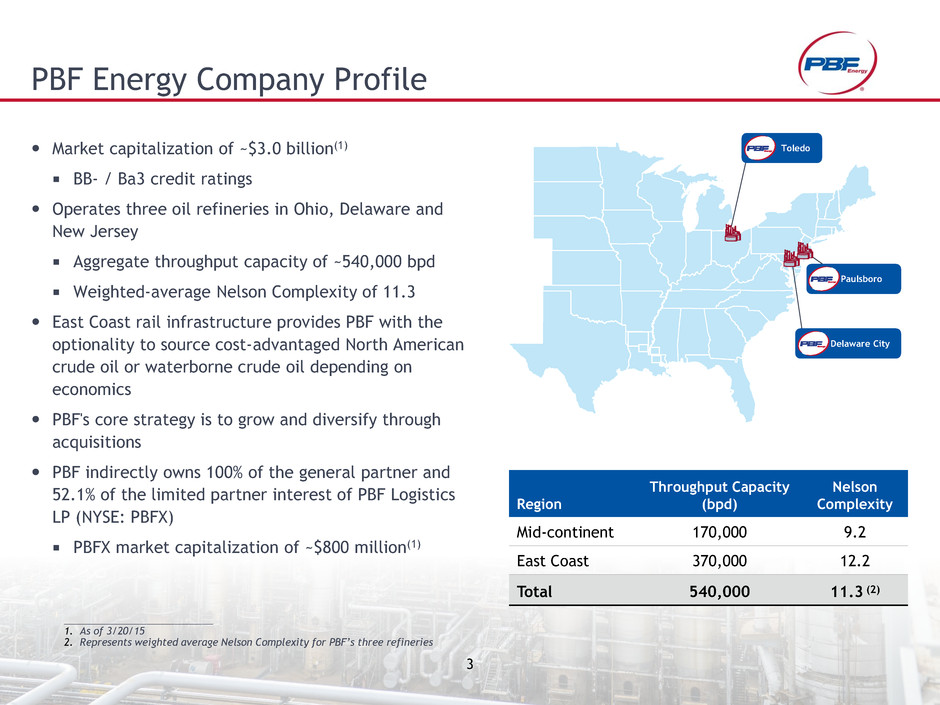
3 PBF Energy Company Profile Market capitalization of ~$3.0 billion(1) BB- / Ba3 credit ratings Operates three oil refineries in Ohio, Delaware and New Jersey Aggregate throughput capacity of ~540,000 bpd Weighted-average Nelson Complexity of 11.3 East Coast rail infrastructure provides PBF with the optionality to source cost-advantaged North American crude oil or waterborne crude oil depending on economics PBF's core strategy is to grow and diversify through acquisitions PBF indirectly owns 100% of the general partner and 52.1% of the limited partner interest of PBF Logistics LP (NYSE: PBFX) PBFX market capitalization of ~$800 million(1) Region Throughput Capacity (bpd) Nelson Complexity Mid-continent 170,000 9.2 East Coast 370,000 12.2 Total 540,000 11.3 (2) ___________________________ 1. As of 3/20/15 2. Represents weighted average Nelson Complexity for PBF’s three refineries Paulsboro Delaware City Toledo
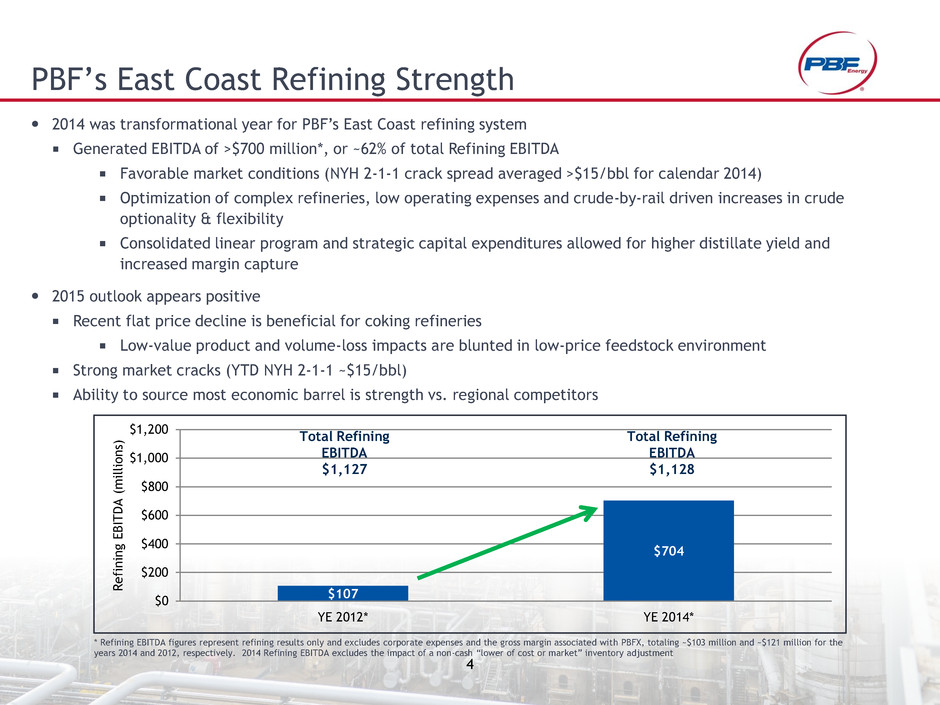
4 PBF’s East Coast Refining Strength $107 $704 $0 $200 $400 $600 $800 $1,000 $1,200 YE 2012* YE 2014* R ef in in g E BI T DA ( m il li o n s) 2014 was transformational year for PBF’s East Coast refining system Generated EBITDA of >$700 million*, or ~62% of total Refining EBITDA Favorable market conditions (NYH 2-1-1 crack spread averaged >$15/bbl for calendar 2014) Optimization of complex refineries, low operating expenses and crude-by-rail driven increases in crude optionality & flexibility Consolidated linear program and strategic capital expenditures allowed for higher distillate yield and increased margin capture 2015 outlook appears positive Recent flat price decline is beneficial for coking refineries Low-value product and volume-loss impacts are blunted in low-price feedstock environment Strong market cracks (YTD NYH 2-1-1 ~$15/bbl) Ability to source most economic barrel is strength vs. regional competitors * Refining EBITDA figures represent refining results only and excludes corporate expenses and the gross margin associated with PBFX, totaling ~$103 million and ~$121 million for the years 2014 and 2012, respectively. 2014 Refining EBITDA excludes the impact of a non-cash “lower of cost or market” inventory adjustment Total Refining EBITDA $1,127 Total Refining EBITDA $1,128
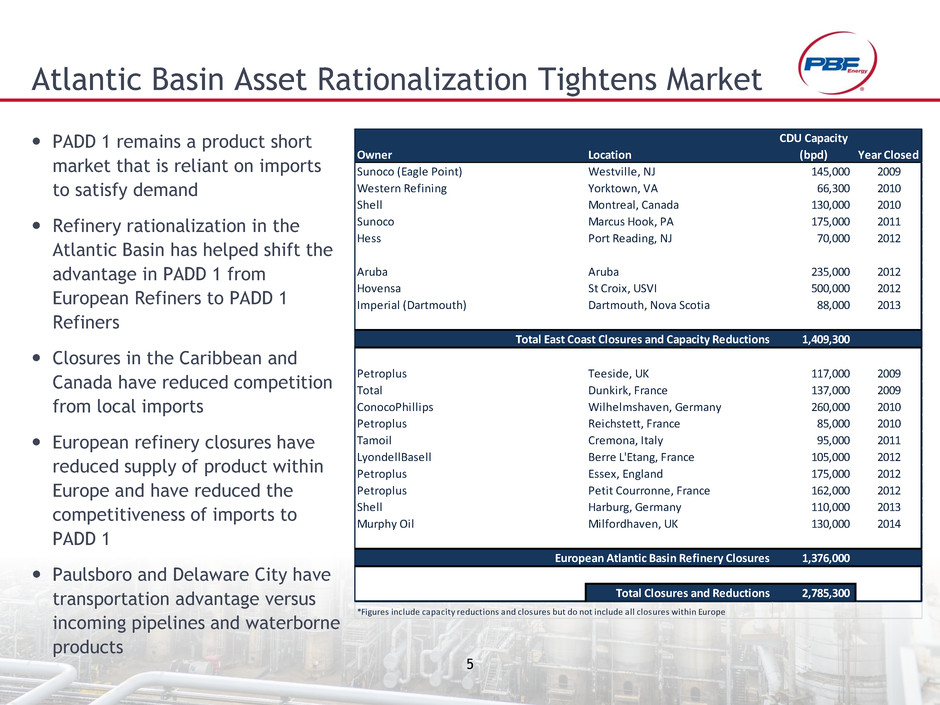
5 Atlantic Basin Asset Rationalization Tightens Market PADD 1 remains a product short market that is reliant on imports to satisfy demand Refinery rationalization in the Atlantic Basin has helped shift the advantage in PADD 1 from European Refiners to PADD 1 Refiners Closures in the Caribbean and Canada have reduced competition from local imports European refinery closures have reduced supply of product within Europe and have reduced the competitiveness of imports to PADD 1 Paulsboro and Delaware City have transportation advantage versus incoming pipelines and waterborne products Owner Location CDU Capacity (bpd) Year Closed Sunoco (Eagle Point) Westville, NJ 145,000 2009 Western Refining Yorktown, VA 66,300 2010 Shell Montreal, Canada 130,000 2010 Sunoco Marcus Hook, PA 175,000 2011 Hess Port Reading, NJ 70,000 2012 Aruba Aruba 235,000 2012 Hovensa St Croix, USVI 500,000 2012 Imperial (Dartmouth) Dartmouth, Nova Scotia 88,000 2013 Total East Coast Closures and Capacity Reductions 1,409,300 Petroplus Teeside, UK 117,000 2009 Total Dunkirk, France 137,000 2009 ConocoPhillips Wilhelmshaven, Germany 260,000 2010 Petroplus Reichstett, France 85,000 2010 Tamoil Cremona, Italy 95,000 2011 LyondellBasell Berre L'Etang, France 105,000 2012 Petroplus Essex, England 175,000 2012 Petroplus Petit Courronne, France 162,000 2012 Shell Harburg, Germany 110,000 2013 Murphy Oil Milfordhaven, UK 130,000 2014 European Atlantic Basin Refinery Closures 1,376,000 Total Closures and Reductions 2,785,300 *Figures include capacity reductions and closures but do not include all closures within Europe
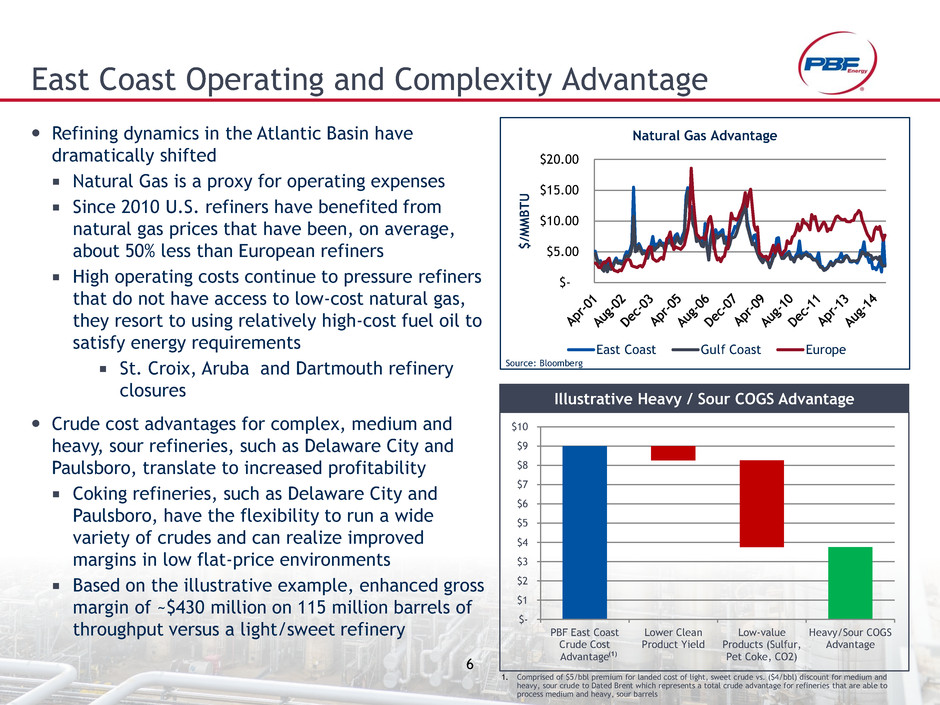
6 Refining dynamics in the Atlantic Basin have dramatically shifted Natural Gas is a proxy for operating expenses Since 2010 U.S. refiners have benefited from natural gas prices that have been, on average, about 50% less than European refiners High operating costs continue to pressure refiners that do not have access to low-cost natural gas, they resort to using relatively high-cost fuel oil to satisfy energy requirements St. Croix, Aruba and Dartmouth refinery closures Crude cost advantages for complex, medium and heavy, sour refineries, such as Delaware City and Paulsboro, translate to increased profitability Coking refineries, such as Delaware City and Paulsboro, have the flexibility to run a wide variety of crudes and can realize improved margins in low flat-price environments Based on the illustrative example, enhanced gross margin of ~$430 million on 115 million barrels of throughput versus a light/sweet refinery East Coast Operating and Complexity Advantage $- $1 $2 $3 $4 $5 $6 $7 $8 $9 $10 PBF East Coast Crude Cost Advantage Lower Clean Product Yield Low-value Products (Sulfur, Pet Coke, CO2) Heavy/Sour COGS Advantage Illustrative Heavy / Sour COGS Advantage ($0.75) ($4.50) $9.00 $3.75 (1) 1. Comprised of $5/bbl premium for landed cost of light, sweet crude vs. ($4/bbl) discount for medium and heavy, sour crude to Dated Brent which represents a total crude advantage for refineries that are able to process medium and heavy, sour barrels $- $5.00 $10.00 $15.00 $20.00 $ /M M B T U Natural Gas Advantage East Coast Gulf Coast Europe Source: Bloomberg
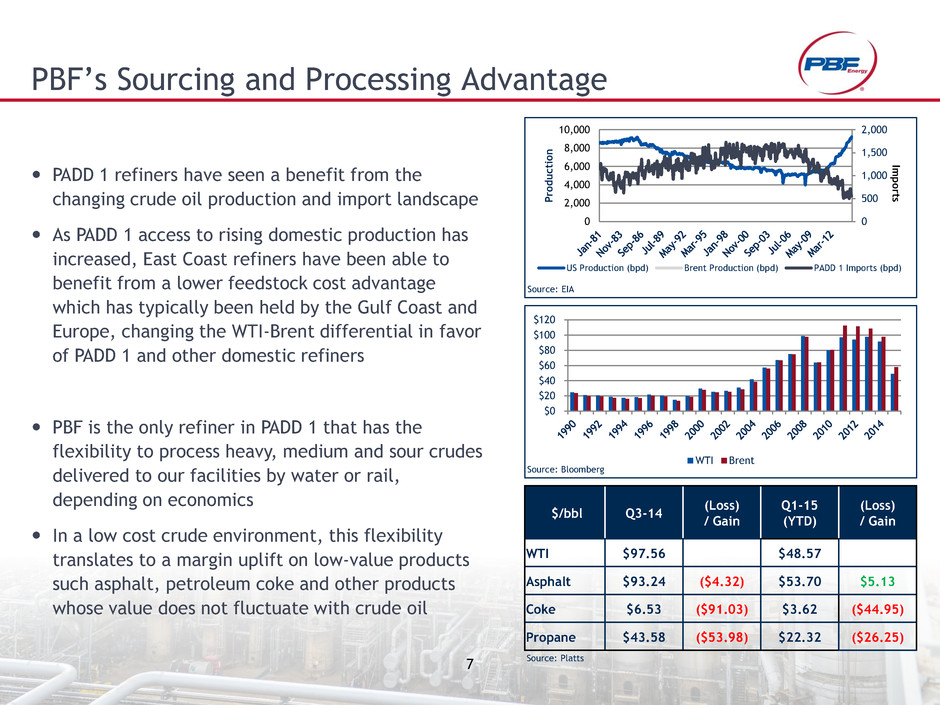
7 PBF’s Sourcing and Processing Advantage PADD 1 refiners have seen a benefit from the changing crude oil production and import landscape As PADD 1 access to rising domestic production has increased, East Coast refiners have been able to benefit from a lower feedstock cost advantage which has typically been held by the Gulf Coast and Europe, changing the WTI-Brent differential in favor of PADD 1 and other domestic refiners PBF is the only refiner in PADD 1 that has the flexibility to process heavy, medium and sour crudes delivered to our facilities by water or rail, depending on economics In a low cost crude environment, this flexibility translates to a margin uplift on low-value products such asphalt, petroleum coke and other products whose value does not fluctuate with crude oil 0 500 1,000 1,500 2,000 0 2,000 4,000 6,000 8,000 10,000 P rod u c tio n US Production (bpd) Brent Production (bpd) PADD 1 Imports (bpd) $0 $20 $40 $60 $80 $100 $120 WTI Brent Source: EIA Source: Bloomberg Im po rts $/bbl Q3-14 (Loss) / Gain Q1-15 (YTD) (Loss) / Gain WTI $97.56 $48.57 Asphalt $93.24 ($4.32) $53.70 $5.13 Coke $6.53 ($91.03) $3.62 ($44.95) Propane $43.58 ($53.98) $22.32 ($26.25) Source: Platts

8 PBF Energy maintains a conservative financial profile with significant liquidity and access to capital markets Availability liquidity of ~$1 billion as of December 31, 2014 In 2014, obtained >$3.3 billion in committed credit facilities Balance sheet strengthened by successful PBF Logistics IPO and drop-downs of Delaware City West Rack and Toledo Storage Facility 2014 transactions contributed net cash proceeds of ~$600 million(2,3) to PBF Energy Strong Balance Sheet Provides a Platform for Growth ___________________________ 1. Excludes the impact of the fourth quarter 2014, non-cash “lower-of-cost-or-market” inventory adjustment 2. Net proceeds received by PBF Logistics from the sale of the 15,812,500 common units totaled approximately $341.0 million, after deducting the underwriting discount and structuring fee, but before taking into account estimated offering expenses 3. Net proceeds received by PBF Energy from the drop-down of the Delaware City West Rack and Toledo Storage Facility were approximately $270 million in cash and $30 million in PBF Logistics LP common units. 10.0% 20.0% 30.0% 40.0% Q2-13 Q3-13 Q4-13 Q1-14 Q2-14 Q3-14 Q4-14 Net Debt to Net Capitalization (1)

9 Increasing Shareholder Value 2014 Summary Returned $260 million to shareholders through dividends and share repurchases Enhanced margin by approximately $170 million, on an annualized basis, through projects implemented in 2014 Launched PBFX in 2014, which strengthened PBF and provides PBF with a valuable partner for growth Generated ~$600 million in net cash proceeds through the IPO and two subsequent drop- downs Increased size of Asset-backed Revolving Credit Facility from $1.6 billion to $2.5 billion, with an accordion to $2.75 billion (maturity extended to 2019) 2015 Outlook Continued focus on organic margin improvement projects in 2015, potential for third-party funding of high-return hydrogen plant project Generate additional cash through drop-down of assets to PBFX Focus on growth through acquisitions

10 Toledo Self-Help *Figures provided are based on a full year of operations using historical prices and subject to change based on project completion timelines, cost of RINs, market and other factors Total margin uplift ~$80 - $90 million/yr* Toledo FCC turnaround Reactor and Stripper Replacement Third-stage separator replacement Increased C3+ liquid yield Total refinery volume gain of 0.5% Aromatics recovery expansion Increased yield of benzene, toluene, xylene Reduced gasoline yield New crude tank Improves feedstock flexibility and minimizes disruptions Dropped down to PBF Logistics in December 2014 In the fourth quarter of 2014 we completed one of the largest turnarounds in the history of the Toledo Refinery. We reinvested ~$180 million in the facility of which ~$80 million was for margin improvement projects.
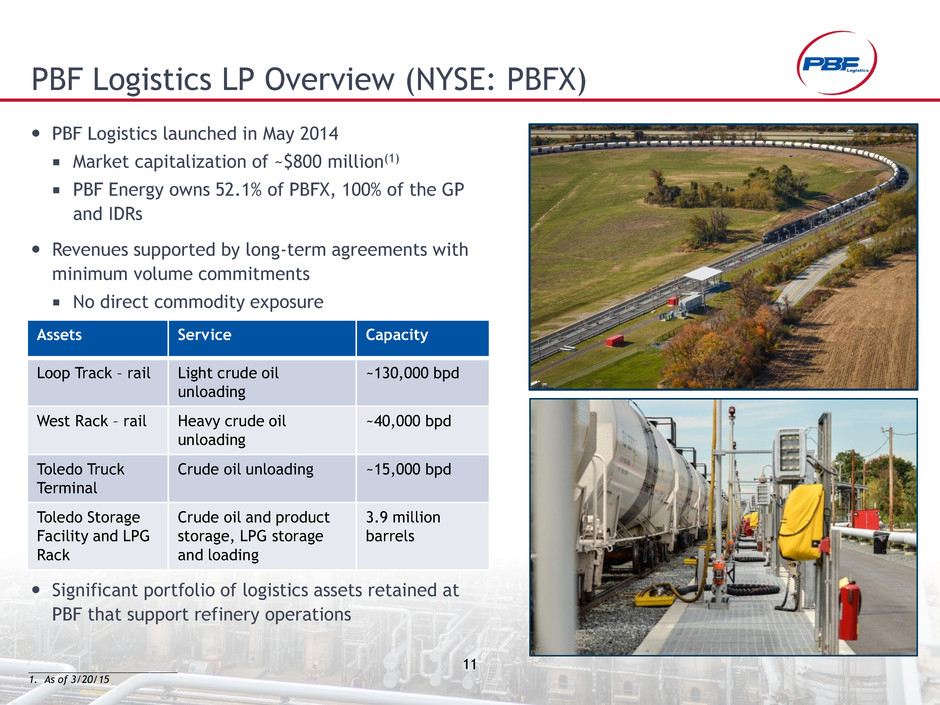
11 PBF Logistics launched in May 2014 Market capitalization of ~$800 million(1) PBF Energy owns 52.1% of PBFX, 100% of the GP and IDRs Revenues supported by long-term agreements with minimum volume commitments No direct commodity exposure Significant portfolio of logistics assets retained at PBF that support refinery operations PBF Logistics LP Overview (NYSE: PBFX) Assets Service Capacity Loop Track – rail Light crude oil unloading ~130,000 bpd West Rack – rail Heavy crude oil unloading ~40,000 bpd Toledo Truck Terminal Crude oil unloading ~15,000 bpd Toledo Storage Facility and LPG Rack Crude oil and product storage, LPG storage and loading 3.9 million barrels ___________________________ 1. As of 3/20/15

12 PBFX Investment Highlights PBFX is the primary vehicle to expand PBF Energy’s (“PBF”) logistics asset base PBF underpins the stability of PBFX’s cash flow 100% of forecast revenue generated through MVCs Long-term, fee-based contracts with minimum volume commitments and inflation escalators PBF is incentivized and economically aligned ~52% LP ownership, in addition to 100% GP and IDR ownership Strategically located, well-maintained and integrated assets East Coast rail facilities supply PBF Energy’s Delaware City and Paulsboro refineries with North American crude oils Mid-continent crude oil truck unloading racks, feedstock and product storage facilities and LPG truck rack provide flexible supply, storage and off-take infrastructure for the Toledo refinery Current and anticipated future drop-down assets are integral to the operations of PBF’s refineries Financial flexibility Significant financial flexibility to execute growth strategy $325 million revolving credit facility with an accordion to $600 million Target debt of 3x – 4x EBITDA Experienced leadership team Significant experience operating and managing logistics and refining assets Long and successful track record of executing profitable acquisitions and driving organic growth Focused on growing logistics assets Relationship with PBF provides growth and stability

13 Robust Drop-down Inventory Retained at PBF Significant growth potential through future drop- downs of logistics infrastructure retained by PBF Energy ~$100 – $125 million of drop-down EBITDA remaining at PBF Energy East Coast Storage Facilities 10.0 million bbls at Delaware City 7.5 million bbls at Paulsboro Multiple marine terminals Adds future export optionality Refined products pipeline and heavy crude oil terminal Additional truck racks, rail terminals and LPG loading/unloading facilities PBFX has ROFO on substantial portfolio of logistics assets retained at PBF

14 PBFX Outlook and Strategy Conservative financial profile with strong liquidity and access to capital markets Target PBFX debt of 3x to 4x EBITDA Return excess cash to shareholders Focus on Stable, Fee-based Business Focused on stable, fee-based business supported by long-term, minimum volume commitments Maintain minimal commodity risk Demonstrate commitment to safe and reliable operations in all areas PBFX provides PBF with vehicle to grow platform and enhance investor returns PBFX’s assets are critical to PBF’s refineries Continually evaluating growth and optimization opportunities Financial Strategic Grow through Acquisitions Invest in growth opportunities to drive further value creation Pursue additional drop-down transactions with sponsor Expand and diversify third-party earnings base
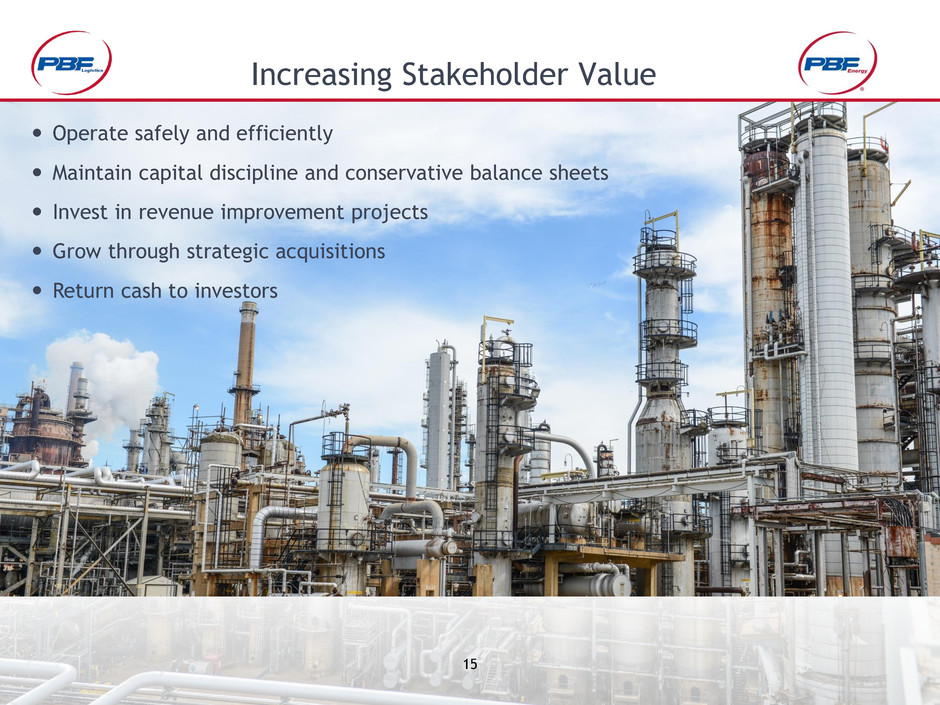
15 Increasing Stakeholder Value Operate safely and efficiently Maintain capital discipline and conservative balance sheets Invest in revenue improvement projects Grow through strategic acquisitions Return cash to investors
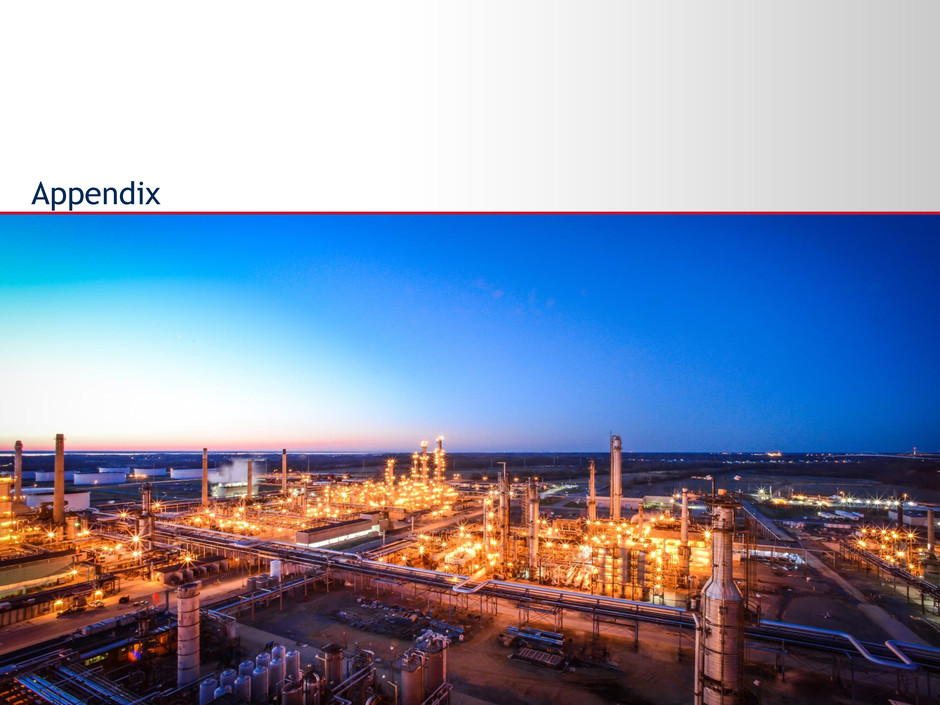
1 6 Appendix
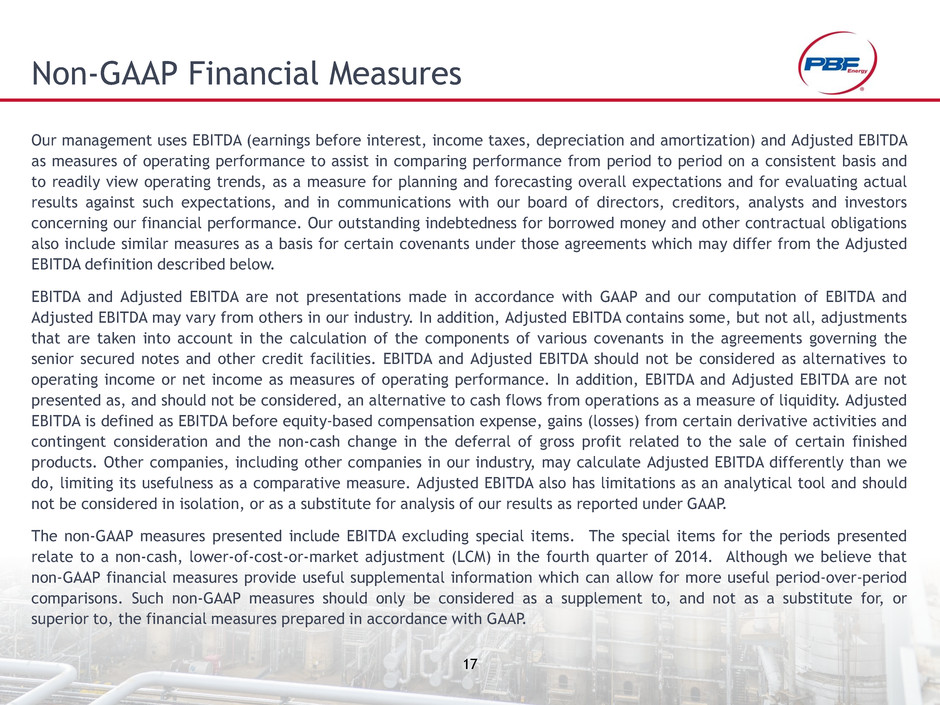
17 Non-GAAP Financial Measures Our management uses EBITDA (earnings before interest, income taxes, depreciation and amortization) and Adjusted EBITDA as measures of operating performance to assist in comparing performance from period to period on a consistent basis and to readily view operating trends, as a measure for planning and forecasting overall expectations and for evaluating actual results against such expectations, and in communications with our board of directors, creditors, analysts and investors concerning our financial performance. Our outstanding indebtedness for borrowed money and other contractual obligations also include similar measures as a basis for certain covenants under those agreements which may differ from the Adjusted EBITDA definition described below. EBITDA and Adjusted EBITDA are not presentations made in accordance with GAAP and our computation of EBITDA and Adjusted EBITDA may vary from others in our industry. In addition, Adjusted EBITDA contains some, but not all, adjustments that are taken into account in the calculation of the components of various covenants in the agreements governing the senior secured notes and other credit facilities. EBITDA and Adjusted EBITDA should not be considered as alternatives to operating income or net income as measures of operating performance. In addition, EBITDA and Adjusted EBITDA are not presented as, and should not be considered, an alternative to cash flows from operations as a measure of liquidity. Adjusted EBITDA is defined as EBITDA before equity-based compensation expense, gains (losses) from certain derivative activities and contingent consideration and the non-cash change in the deferral of gross profit related to the sale of certain finished products. Other companies, including other companies in our industry, may calculate Adjusted EBITDA differently than we do, limiting its usefulness as a comparative measure. Adjusted EBITDA also has limitations as an analytical tool and should not be considered in isolation, or as a substitute for analysis of our results as reported under GAAP. The non-GAAP measures presented include EBITDA excluding special items. The special items for the periods presented relate to a non-cash, lower-of-cost-or-market adjustment (LCM) in the fourth quarter of 2014. Although we believe that non-GAAP financial measures provide useful supplemental information which can allow for more useful period-over-period comparisons. Such non-GAAP measures should only be considered as a supplement to, and not as a substitute for, or superior to, the financial measures prepared in accordance with GAAP.
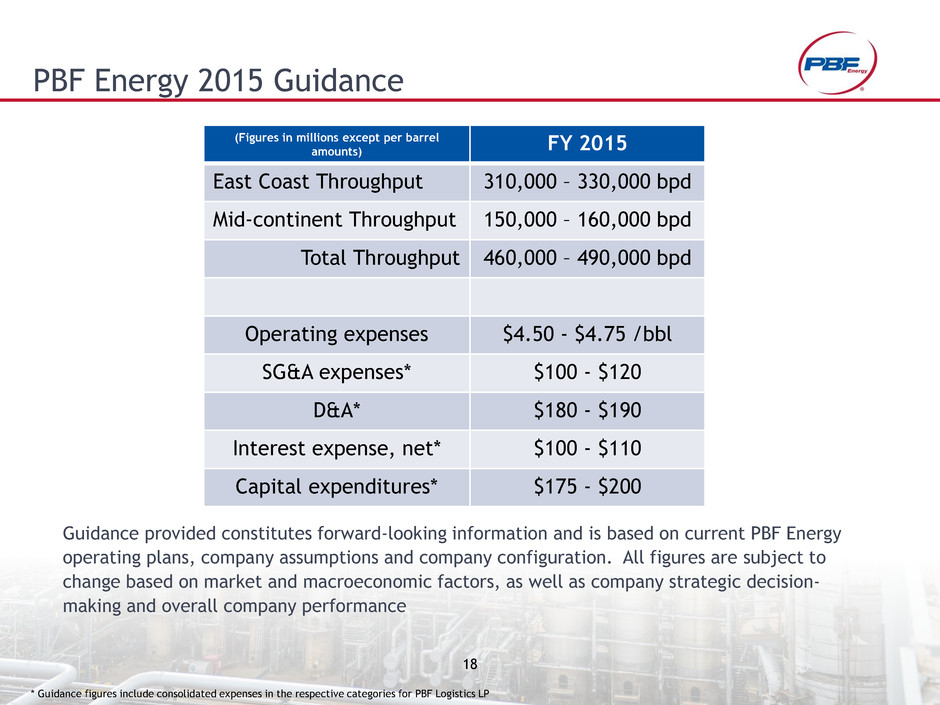
18 PBF Energy 2015 Guidance Guidance provided constitutes forward-looking information and is based on current PBF Energy operating plans, company assumptions and company configuration. All figures are subject to change based on market and macroeconomic factors, as well as company strategic decision- making and overall company performance (Figures in millions except per barrel amounts) FY 2015 East Coast Throughput 310,000 – 330,000 bpd Mid-continent Throughput 150,000 – 160,000 bpd Total Throughput 460,000 – 490,000 bpd Operating expenses $4.50 - $4.75 /bbl SG&A expenses* $100 - $120 D&A* $180 - $190 Interest expense, net* $100 - $110 Capital expenditures* $175 - $200 * Guidance figures include consolidated expenses in the respective categories for PBF Logistics LP

19 PBFX 2015 Guidance Guidance provided constitutes forward-looking information and is based on current PBF Logistics operating plans, assumptions and configuration. All figures are subject to change based on market and macroeconomic factors, as well as management’s strategic decision- making and overall Partnership performance (Figures in millions) FY 2015 Revenues $122.0 Operating expenses $35.0 SG&A $10.5 D&A $5.8 Interest expense, net $8.5 Maintenance capital expenditures $5.2 Targeted distribution coverage 1.15x Leverage target 3x-4x EBITDA • All figures are based on minimum volume commitments under existing long-term agreements
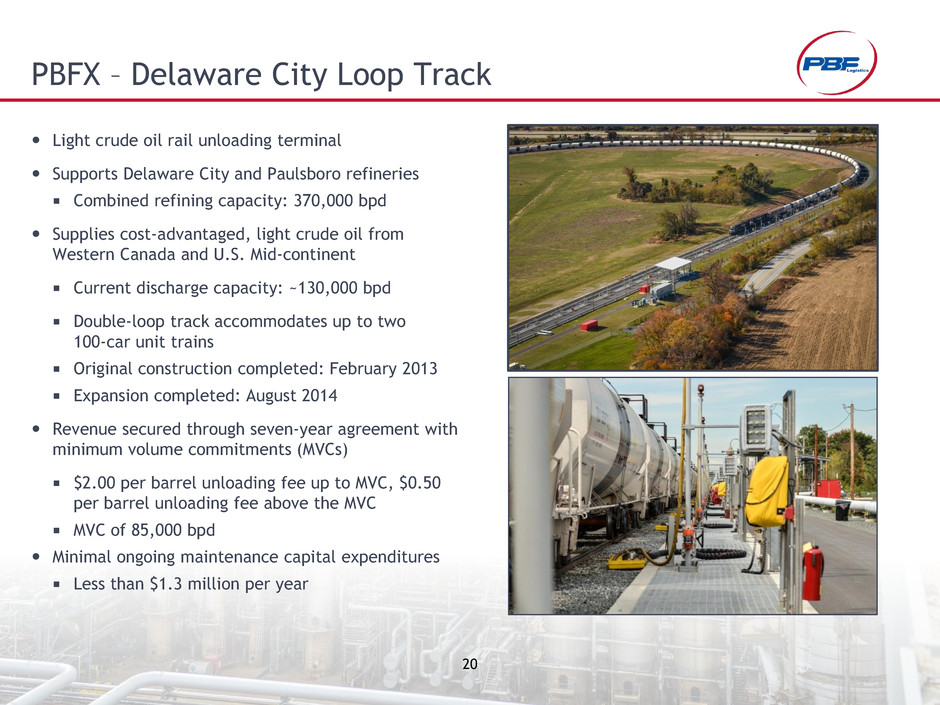
20 PBFX – Delaware City Loop Track Light crude oil rail unloading terminal Supports Delaware City and Paulsboro refineries Combined refining capacity: 370,000 bpd Supplies cost-advantaged, light crude oil from Western Canada and U.S. Mid-continent Current discharge capacity: ~130,000 bpd Double-loop track accommodates up to two 100-car unit trains Original construction completed: February 2013 Expansion completed: August 2014 Revenue secured through seven-year agreement with minimum volume commitments (MVCs) $2.00 per barrel unloading fee up to MVC, $0.50 per barrel unloading fee above the MVC MVC of 85,000 bpd Minimal ongoing maintenance capital expenditures Less than $1.3 million per year
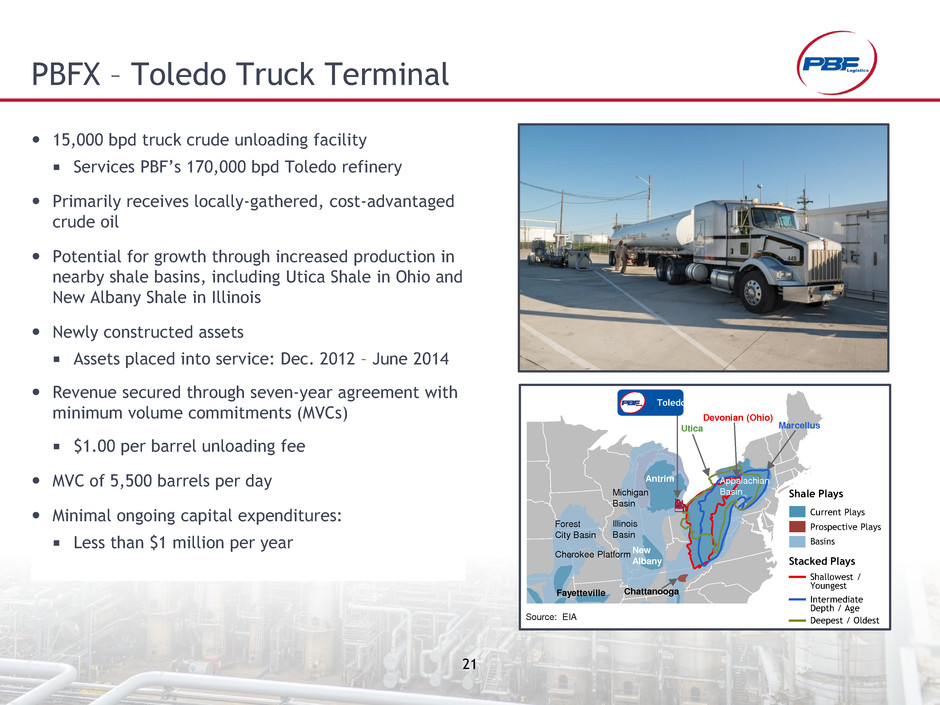
21 PBFX – Toledo Truck Terminal 15,000 bpd truck crude unloading facility Services PBF’s 170,000 bpd Toledo refinery Primarily receives locally-gathered, cost-advantaged crude oil Potential for growth through increased production in nearby shale basins, including Utica Shale in Ohio and New Albany Shale in Illinois Newly constructed assets Assets placed into service: Dec. 2012 – June 2014 Revenue secured through seven-year agreement with minimum volume commitments (MVCs) $1.00 per barrel unloading fee MVC of 5,500 barrels per day Minimal ongoing capital expenditures: Less than $1 million per year Illinois Basin Appalachian Basin New Albany Devonian (Ohio) Marcellus Utica Michigan Basin Antrim Forest City Basin Fayetteville Cherokee Platform Chattanooga Source: EIA Toledo Current Plays Prospective Plays Basins Shale Plays Stacked Plays Intermediate Depth / Age Deepest / Oldest Shallowest / Youngest

22 PBFX – Delaware City Heavy Crude Unloading Rack “West Rack” - heavy crude oil rail unloading terminal Current discharge capacity: 40,000 bpd Unit-train capable, steam and nitrogen equipped to unload heavy crude oil and bitumen Construction completed and in-service in August 2014 Primarily supplies cost-advantaged, heavy crude oil and bitumen from Western Canada In-service date coincides with completion of unit-train capable loading facilities in Canada Revenue secured through seven-year agreement with minimum volume commitments (MVCs) $2.20 per barrel unloading fee up to MVC, $1.50 per barrel unloading fee above the MVC MVC of 40,000 bpd Annual maintenance capex of approximately $1.25 million
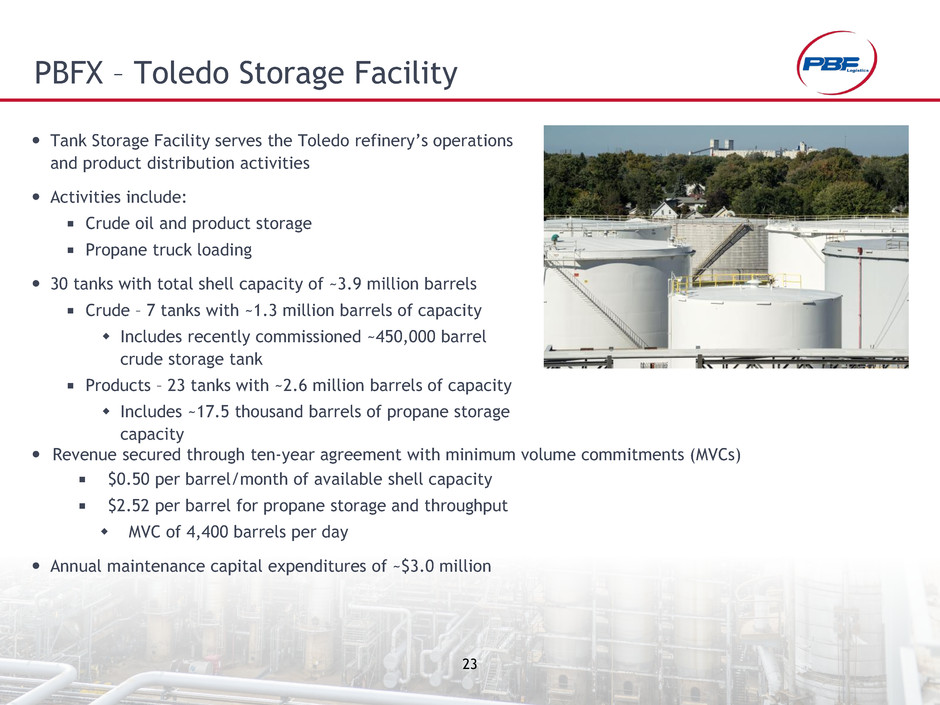
23 Tank Storage Facility serves the Toledo refinery’s operations and product distribution activities Activities include: Crude oil and product storage Propane truck loading 30 tanks with total shell capacity of ~3.9 million barrels Crude – 7 tanks with ~1.3 million barrels of capacity Includes recently commissioned ~450,000 barrel crude storage tank Products – 23 tanks with ~2.6 million barrels of capacity Includes ~17.5 thousand barrels of propane storage capacity PBFX – Toledo Storage Facility Revenue secured through ten-year agreement with minimum volume commitments (MVCs) $0.50 per barrel/month of available shell capacity $2.52 per barrel for propane storage and throughput MVC of 4,400 barrels per day Annual maintenance capital expenditures of ~$3.0 million
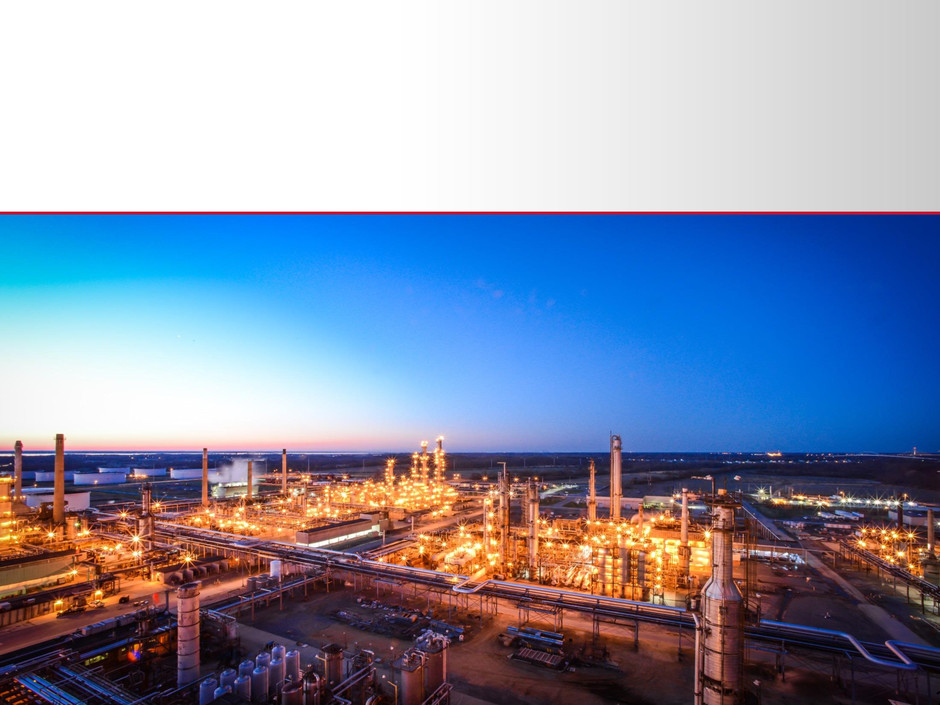
2 4
